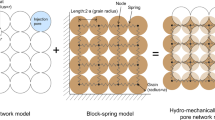Abstract
Pressure gradients during uniform fluid flow in porous media are traditionally assumed to be linear. Thus, pressure loss across a sample of porous medium is assumed directly proportional to the thickness of the sample. In this study, measurements of pressure gradients inside coarse granular (2–18 mm particle size) porous media during steady gas flow were carried out. The results showed that pressure variation with distance in the porous media was nonlinear near the inlet (where pressure gradients were higher) but became linear at greater distances (with a lower gradient). This indicates that the pressure loss in porous media consists of two components: (1) a linear pressure gradient and (2) an initial pressure loss near the inlet. This initial pressure loss is also known from hydraulics in tubes as a minor loss and is associated with abrupt changes in the flow field such as narrowings and bends. The results further indicated that the minor loss depends on the particle size and particle size distribution in a manner similar to that of the linear pressure gradient. There is, thus, a close relation between these two components. In porous media, the minor loss is not instantaneous at the inlet point but happens over some distance starting upstream from the inlet and ending some distance downstream.










Similar content being viewed by others
References
Andreasen, R. R., & Poulsen, T. G. (2013). Air flow characteristics in granular biofilter media. Journal of Environmental Engineering, 139(2), 196–204.
Andreasen, R. R., Nicolai, R. E., & Poulsen, T. G. (2012). Pressure drop in biofilters as related to dust and biomass accumulation. Journal of Chemical Technology and Biotechnology, 87(6), 806–816.
Antohe, B. V., Lage, J. L., Price, D. C., & Weber, R. M. (1997). Exper-imental determination of permeability and inertia coefficients of mechanically compressed aluminum porous matrices. Journal of Fluids Engineering, 119(2), 404–412.
Blanes, V., & Pedersen, S. (2005). Ventilation flow in pig houses measured and calculated by carbon dioxide, moisture and heat balance equations. Biosystems Engineering, 92(4), 483–493.
Cornell, D., & Katz, D. S. (1953). Flow of gases through consolidated porous media. Industrial and Engineering Chemistry, 45, 2145–2152.
Darcy, H. (1856). Les fontaines publiques de la ville de Dijon. Paris: Victor Dalmont (in French).
Datta, I., & Allen, D. G. (2005). Biofilter technology. In Z. Shareefden & A. Singh (Eds.), Biotechnology for odor and air pollution control (pp. 125–145). Heidelberg: Springer.
Delhomenie, M.-C., & Heitz, M. (2005). Biofiltration of air: a review. Critical Reviews in Biotechnology, 25, 53–72.
Deshusses, M. A. (1997). Biological waste air treatment in biofilters. Current Opinion in Biotechnology, 8, 335–339.
Dorado, A. D., Lafuente, J., Gabriel, D., & Gamisans, X. (2010). The role of water in the performance of biofilters: parameterization of pressure drop and sorption capasities for common packing materials. Journal of Hazardous Materials, 180, 693–702.
Ergun, S. (1952). Fluid flow through packed columns. Chemical Engineering Progress, 48(2), 89–94.
Forchheimer, P. (1901). Wasserbewegung durch boden (in German). Zeitschrift des Vereines Deutscher Ingenieure, 45, 1782–1788.
Geertsma, J. (1979). Estimating the coefficient of inertial resistance in fluid flow through porous media. Society of Petroleum Engineers Journal, 1974, 445–450.
Green, L., & Duwez, P. (1951). Fluid flow through porous materials. Journal of Applied Mechanics, 18, 39–45.
Lage, J. L., Antohe, B. V., & Nield, D. A. (1997). Two types of nonlinear pressure-drop versus flow-rate relation observed for saturated porous media. Journal of Fluids Engineering, 119(3), 700–706.
Macdonald, I. F., El-sayed, M. S., Mow, K., & Dullien, F. A. L. (1979). Flow through porous media—the Ergun equation revisited. Industrial and Engineering Chemistry Fundamentals, 18(3), 199–208.
Macdonald, M. J., Chu, C. F., Guilloit, P. P., & Ng, K. M. (1991). A generalized Blake-Kozeny equation for multisized spherical-particles. AICHE Journal, 37(10), 1583–1588.
Munson, R. B., Young, D. F., & Okiishi, T. H. (2006). Fundamentals of fluid mechanics. New York: Wiley.
O’Neill, D. H., Stewart, I. W., & Phillips, V. R. (1992). A review of the control of odour nuisance from livestock buildings: part 2, the costs of odour abatement systems as predicted from ventilation requirements. Journal of Agricultural Engineering Research, 51, 157–165.
Pugliese, L., Poulsen, T. G., & Andreasen, R. R. (2013). Gas pressure loss during transport in porous biofilter media as related to media particle size and particle shape. Manuscript to be submitted to Journal of Environmental Engineering.
Revah, S., & Morgan-Sagastume, J. M. (2005). Methods of odor and VOC control. In Z. Shareefdeen & A. Singh (Eds.), Biotechnology for odor and air pollution control (pp. 29–63). Heidelberg: Springer.
Schlegelmilch, M., Streese, J., Biedermann, W., Herold, T., & Stegmann, R. (2005). Odour control at biowaste composting facilities. Waste Management, 25, 917–927.
Schwarz, B. C. E., Devinny, J. S., & Tsotsis, T. T. (2001). A biofilter network model—importance of the pore structure and other large-scale heterogeneities. Chemical Engineering Science, 56, 475–483.
Shareefdeen, Z., Herner, B., Webb, D., & Wilson, S. (2003). Biofiltration eliminates nuisance chemical odors from industrial air streams. Journal of Industrial Microbiology and Biotechnology, 30, 168–174.
Shareefdeen, Z., Herner, B., & Singh, A. (2005). Biotechnology for odor and air pollution control . Heidelberg: Springer.
Sharma, P., & Poulsen, T. G. (2010). Gas dispersion and immobile gas volume in solid and porous particle biofilter materials at low air flow velocities. Journal of the Air and Waste Management Association 60, 830–837.
Trussell, R. R., & Chang, M. (1999). Review of flow through porous media as applied to head loss in water filters. Journal of Environmental Engineering, 125(11), 998–1006.
Yang, H., & Allen, D. G. (2005). Potential improvement in biofilter design through the use of heterogeneous packing and a conical biofilter geometry. Journal of Environmental Engineering, 131(4), 504–511.
Author information
Authors and Affiliations
Corresponding author
Rights and permissions
About this article
Cite this article
Poulsen, T.G., Minelgaite, G., Bentzen, T.R. et al. Minor Losses During Air Flow into Granular Porous Media. Water Air Soil Pollut 224, 1666 (2013). https://doi.org/10.1007/s11270-013-1666-2
Received:
Accepted:
Published:
DOI: https://doi.org/10.1007/s11270-013-1666-2




